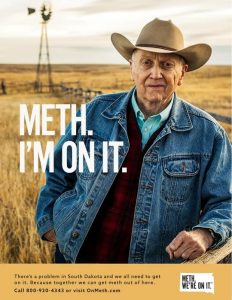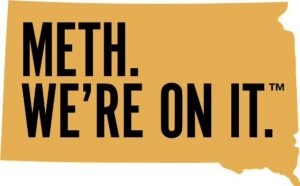A story in this week’s newsletter is already being discussed intently online, so let’s jump in. Let’s start with True’s version of the story, from the 24 November 2019 issue:
You’d Have to Be on Drugs
to Think this Was a Good Idea
South Dakota Gov. Kristi Noem personally launched a new ad campaign to combat her state’s methamphetamine epidemic, which is “growing at an alarming rate,” she says. “It is filling our jails and prisons, clogging our court systems and stretching our drug treatment capacity.” So far, the state has paid Broadhead Co., a Minneapolis, Minn., marketing and ad agency, nearly a half million dollars toward a $1.4 million contract to come up with the attention-getting campaign. “This is our problem, and together, we need to get on it,” said the Republican governor. “This a bold, innovative effort like the nation has never before seen.” The tagline for the campaign: “Meth. We’re On It.” (RC/Sioux Falls Argus Leader) …It does seem so.
Reaction is Pretty Much Universal
Marketing experts are calling the campaign “a colossal blunder,” reports the Washington Post. “Obviously everyone gets the play on words, they’re trying a twist,” said Beth Egan, an associate professor for advertising at Syracuse University. “But what they’re missing is that advertisers no longer have control over the conversation. You need to be mindful of how consumers are gonna take it and run with it in their own way.”
Indeed, “Any good marketer would look at this and say: ‘Yeah, let’s not do that’,” said Bill Pearce, the assistant dean at the University of California/Berkeley’s School of Business. “Nobody thought about the ramifications. The Twitter reactions are hysterical.”
No surprise.

The print ads (example shown here) feature ordinary people from the state with a giant, superimposed message, “METH. I’M ON IT.” That just makes it look like “everyone” in the state is using the drug. The real epidemic is in the 12(!!) to 17 age range: that group in South Dakota has twice the rate of meth use than the national average, yet they’re the least likely to see the ad messages, marketing wonks say.
The governor is fighting back. “South Dakota’s anti-meth campaign launch is sparking conversations around the state and the country,” Noem said. “The mission of the campaign is to raise awareness — to get people talking about how they can be part of the solution and not just the problem. It is working.” Dean Pearce rejects that: “There’s another trope that goes, ‘When they’re running you out of town, pick up a baton and pretend you’re leading the parade’,” he said.

They’re even claiming a trademark (TM) on the logo and/or tagline: they’re not just on it, they’re all in.
It’s obvious why this is an “effort like the nation has never before seen.” But hey: at least the state succeeded in the goal “to get people talking”! Let’s hope the campaign actually does some good.
– – –
Bad link? Broken image? Other problem on this page? Use the Help button lower right, and thanks.
This page is an example of my style of “Thought-Provoking Entertainment”. This is True is an email newsletter that uses “weird news” as a vehicle to explore the human condition in an entertaining way. If that sounds good, click here to open a subscribe form.
To really support This is True, you’re invited to sign up for a subscription to the much-expanded “Premium” edition:
Q: Why would I want to pay more than the minimum rate?
A: To support the publication to help it thrive and stay online: this kind of support means less future need for price increases (and smaller increases when they do happen), which enables more people to upgrade. This option was requested by existing Premium subscribers.

This is simple to fix:
“Meth. I’m NOT on it. Join me! Be Meth Free.”
Sigh. Sad, Sad, Sad.
And even my “improvement” is no panacea. But I am no Solomon. And no one paid me a million!
—
But you’re right: it’s an improvement, and it probably only took you 10 seconds to come up with it! -rc
“Meth. I’m NOT on it. Join me! Be Meth Free.”
Now THAT’S a great slogan, Pete! MUCH better than SD’s version.
Thank you. Let us hope that ONE or the OTHER slogan, along with some good hard real practical work, can solve the real problem: How and why kids get addicted, and how can we turn them away?
I wonder what ideas others here might propose to get the state (and other states and provinces — like Ontario) clean, safer, and happier.
I’m now aware the governor of South Dakota is on meth. That was worth $1.4 million dollars, right?
—
You’ll have to ask her constituents! -rc
I strongly disagree with the marketing “experts” that you referenced. I think tech writer John Gruber explained it best, here.
He notes, “A campaign with the same budget and an anodyne slogan like ‘Just Say No’ or ‘We’re Here to Help’ would have gotten zero attention inside South Dakota, let alone nationwide. But here we are, one day after the campaign launched, and South Dakota’s meth problem is at the top of the news nationwide. That’s not good advertising; that’s great advertising.”
Yes, of course Twitter had a field day with it. (What doesn’t Twitter have a field day with?) But every time someone mentioned it, whether ridiculing it or not, it was furthering the campaign’s legs.
You’re talking about it nearly a week later. It got your attention enough to land in your newsletter. Again, it was for ridicule, but it was still mentioned, and how many more people are now aware of it?
The whole point of the campaign was for “consumers [to] take it and run with it in their own way,” to quote one of your experts, because that’s what gets people talking and thinking about it. To say that nobody involved with it thought about the ramifications, as your other expert did, is just absurd. Who registers the domain name OnMeth.com without understanding what they’re doing?
This will go down as probably the most talked about drug addiction awareness campaigns in history, mark my words. And getting people talking about it is a large majority of the battle.
—
I was hoping someone would argue the other side. Still, “talking about it” is far from enough: we’ve been talking about it for generations (whether it’s pot, LSD, heroin, etc. etc. etc., and now meth), yet we’re still committed to the “war on drugs” that has been proven not to work. “DARE” has been proven not to work. And more. Still, as an optimistic sort, I did end with “Let’s hope the campaign actually does some good.” And I do have that hope. -rc
I’m with Kevin on this. While people have been aware of this, the campaign has pushed the issue into the spotlight.
I don’t agree with the principle of “any publicity is good publicity”. An improved version I think they are achieving is “draw attention to yourself, on your own terms”.
They may not have direct control over the conversation (the likes of twitter make that incredibly difficult), but they are deliberately drawing attention, in a manner of their choosing. Much like Kevin is saying, it is virtually impossible that nobody involved has looked at the slogan and not seen how it appears.
The attention may be ridicule, but it is generally in good humour, as opposed to harsh negativity, and we are still talking about it later. Even outside the US.
The discussion about this really is what This is True is all about. It makes you think deeply.
I’m also going to support the campaign. By breaking the “silence” about how many people are on Meth — and a crapload of other drugs, legal and illegal — maybe we can get folks to start talking about how to fix the problem rather than “just say no”. If being on Meth is only something that the losers have a problem with, then it can be stigmatized as a personal problem, but if it’s a problem for everybody, then hopefully society as a whole will start to look at it as a public health crisis instead.
This is so embarrassing for the state!
The comments seem to say for the most part, that this was an error. I disagree. I think that many people knew exactly what they were doing with this, including the sought for “misunderstanding”. I would not put this down to stupidity. These discussions, this ambiguity which provokes discussion etc., is exactly what the creators had in mind. And indeed it is putting this problem into the public realm and making people aware of the problem. Whether it will have the desired effect of reducing addiction levels remains to be seen. But at least it is better than the “war” on drugs.
—
I certainly agree with your last sentence! People can believe they know “exactly what they were doing” and still make errors. Certainly the idea was to provoke discussion, but see my reply to “Kevin, Minnesota” above. While I still “hope the campaign actually does some good,” your second-to-last sentence goes here. -rc
They didn’t make an “error” — they made a “methtake” that turned into a “meth double-take.”
I see that most of you would like to find a solution to the problem of young people on drugs. I’m afraid the Western World has lost the way to that solution. I have been around for over 80 years & have experienced the ravages of war in Europe as a child and teenager. Even with hunger and poverty after that war, we had hope. What hope have young people today? Insecurity of adequate employment and the never-ending alarmist media reports of impending disaster of one kind or another makes them feel they have to go and demonstrate, or they give up and use drugs to dull the pain. And I didn’t even mention the spiritual emptiness of today’s materialistic philosophy.
You said a mouthful, there! And for most, it is a correct mouthful!
NOT all youth. Just too many of them. They cannot hope for as good, or as stable a life as their parents had. It IS, and will be a time of too much change, too rapidly, with no outcome in sight, and no matter what you try to get into, no guarantees it will be around. Theft and drug dealing though, seem to be permanent and profitable careers today. SAD!
That and it seems, sex crimes.
Interesting enough, the ad shows a senior with the caption. The reality is, meth is not so much of a problem with seniors as pain killers tend to be. As we get older, we have more aches and pains, and it is not unusual for doctors to prescribe strong pain relievers with an ongoing basis, creating addiction. Our world is a circle of drugs, high medical cost and stress for the elderly, up to and including seniors getting together to ‘swap medications’ as a family member did. We have a family member, addicted to hydrocodone, when she really did not seem to need it. Swapping out they drug with Tylenol, then tictacs and finally a drop or two of CBD oil seem to have resolved the problem. Our country seems to be bent on drugs for the elderly as well. Meth IS a major problem. No question about it. And it DID get the attention. And the problem is bigger than just meth.
Seniors, the Unintentional Drug Addicts.